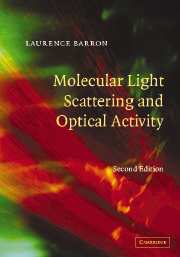Book contents
- Frontmatter
- Contents
- Preface to the first edition
- Preface to the second edition
- List of symbols
- 1 A historical review of optical activity phenomena
- 2 Molecules in electric and magnetic fields
- 3 Molecular scattering of polarized light
- 4 Symmetry and optical activity
- 5 Natural electronic optical activity
- 6 Magnetic electronic optical activity
- 7 Natural vibrational optical activity
- 8 Antisymmetric scattering and magnetic Raman optical activity
- References
- Index
1 - A historical review of optical activity phenomena
Published online by Cambridge University Press: 07 August 2009
- Frontmatter
- Contents
- Preface to the first edition
- Preface to the second edition
- List of symbols
- 1 A historical review of optical activity phenomena
- 2 Molecules in electric and magnetic fields
- 3 Molecular scattering of polarized light
- 4 Symmetry and optical activity
- 5 Natural electronic optical activity
- 6 Magnetic electronic optical activity
- 7 Natural vibrational optical activity
- 8 Antisymmetric scattering and magnetic Raman optical activity
- References
- Index
Summary
Yet each in itself – this was the uncanny, the antiorganic, the life-denying character of them all – each of them was absolutely symmetrical, icily regular in form. They were too regular, as substance adapted to life never was to this degree – the living principle shuddered at this perfect precision, found it deathly, the very marrow of death – Hans Castorp felt he understood now the reason why the builders of antiquity purposely and secretly introduced minute variations from absolute symmetry in their columnar structures.
Thomas Mann (The Magic Mountain)Introduction
In the Preface, an optical activity phenomenon was defined as one whose origin may be reduced to a different response of a system to right- and left-circularly polarized light. This first chapter provides a review, from a historical perspective, of the main features of a range of phenomena that can be classified as manifestations of optical activity, together with a few effects that are related but are not strictly examples of optical activity. The reader is referred to the splendid books by Lowry (1935), Partington (1953) and Mason (1982) for further historical details.
The symbols and units employed in this review are those encountered in the earlier literature, which uses CGS units almost exclusively; but these are not necessarily the same as those used in the rest of the book in which the theory of many of the phenomena included in the review are developed in detail from the unified viewpoint of the molecular scattering of polarized light.
- Type
- Chapter
- Information
- Molecular Light Scattering and Optical Activity , pp. 1 - 52Publisher: Cambridge University PressPrint publication year: 2004



